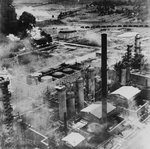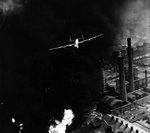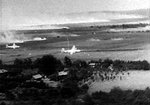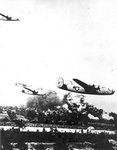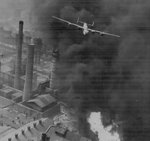syscom3
Pacific Historian
I was waiting for my post # 8000 for the anniversary of this event.
Operation Tidal Wave was a World War II aerial bombardment operation by a composite strike force of five bomb groups from the United States Eighth and Ninth Air Forces to destroy the oil refineries at Ploieşti, Romania, on 1 August 1943. The operation was devised by Colonel (later General) Jacob E. Smart based on the experiences derived from the June 1942 Halverson Project (HALPRO) raid. This attack, by 12 B-24Ds of the Halverson Project, which eventually provided the nucleus for the 376th Bomb Group "Liberandos," caused minimal damage, but demonstrated the feasibility of such a mission in the eyes of American planners. Operation Tidal Wave involved a total commitment of 178 B-24 Liberator heavy bombers on a 2,400-mile round trip flight to conduct low-level attack on the refineries. All aircraft were based near Benghazi, Libya. Brigadier General Uzal Girard Ent was in overall command of American forces during the mission. The operation was notable as one of the most costly in terms of aircraft and crew members lost by the United States Army Air Forces during the strategic bombing campaign over Europe and resulted in five Medal of Honor recipients.
Preparations
Unlike the HALPRO raid, Operation Tidal Wave involved extensive preparation and planning. The 9th Air Force was responsible for the overall conduct for the raid, providing the 98th and 376th Bomb Groups to this effect. The as yet partially formed 8th Air Force would provide three additional bomb groups, the 44th, 93rd, and 389th to round out the mission force. Relying on experiences gleaned from the Halpro raid, Col. Smart developed a plan relying on a day-light, low-level approach to the target area in order to counter German radar coverage. Minimal air defenses encountered during the Halpro raid also contributed to the decision to rely on a low-level approach, although this assessment would later prove to be in error. The arrival of the five groups would be synchronized to strike seven targets in the Ploesti oil fields simultaneously. Training included extensive review of detailed sand table models, practice raids over a mock-up of the target in the Libyan desert and practical exercises over a number of secondary targets in July to prove the viability of such a low level strike. The normally high-altitude B-24D Liberators to be used in the strike were re-equipped with bomb bay fuel tanks to increase capacity to 3,100 gallons in order to achieve the desired 2,000 mile range needed to execute the mission. The strike force was planned for 1 August 1943 and was to consist of 178 aircraft, a total of 1,764 personnel, being one of the largest commitments of American heavy bombers and crewmen up to that time. The mission route would take the mission force from their airfields around Benghazi, Libya across the Mediterranean and Adriatic, past the island of Corfu. Flying over the Pindus Mountains of Albania and across southern Yugoslavia. Following a series of pre-determined way points the formation would turn toward Ploieşti and simultaneously strike their multiple targets from the north.
Unknown to Col. Smart and other American planners, German General Alfred Gerstenberg, in charge of overall air defenses for Axis forces in Romania had used the Halpro attack as justification to build one of the heaviest, and moreover, integrated air defense networks in Europe. Defending the Ploieşti area specifically, Gerstenberg employed several hundred air defense artillery pieces, ranging in size from 105 mm and 88 mm, to a myriad of smaller calibers camouflaged in hay stacks and false structures. A number of pieces were also ingeniously disguised on false sided rolling stock, in order to provide mobile air defenses along the surrounding railway. Gerstenberg tied these defenses into a responsive radar network that could vector 52 Messerschmitt Bf 109 and Messerschmitt Bf 110 fighters along with a number of other (obsolescent) Romanian and Bulgarian fighters against attackers. Gerstenberg also relied on signals intelligence based in Athens, Greece to achieve greater awareness of preparations being made by the 9th Air Force from as far away as North Africa.
Early on the morning of 1 August 1943 the five groups comprising the strike force began lifting off from their home air fields around Benghazi. Large amounts of dust kicked up during take-off created visibility issues and strained engines already carrying the burden of large bomb loads and additional fuel. These conditions contributed to the loss of one aircraft during take-off and resulted in a total of 177 of the original 178 planned aircraft assembling to take part in the actual strike. The formation reached the Adriatic Sea without further incident, however aircraft #28 "Wingo Wango" belonging to the 376th and piloted by Lt. Brian Flavelle began to fly erratically before plunging into the sea due to unknown causes. Lt. Guy Iovine, a personal friend of Flavelle and piloting aircraft #23 "Desert Lilly" descended from the formation in order to look for survivors, narrowly missing aircraft #36 piloted by Lt. John Palm. No apparent survivors were found and due to the additional weight of fuel, Iovine was unable to regain altitude to rejoin the formation and resume course to Ploieşti. The resulting confusion was compounded by the inability to regain cohesion due to strict radio silence maintained as per mission guidance. Ten other aircrews would opt return to friendly air fields following the incident and those aircraft which remained faced the 9,000 foot climb over the Pindus, which were shrouded in cloud cover. Although all five groups crossed made the climb around 11,000 feet, the 376th and 93rd utilizing high power settings began to lose the trailing formations, causing variations in speed and time disrupting the careful strike synchronization deemed so important by Smart.
The possible threat to successful execution was deemed to be of secondary concern to the operational security of the mission by senior leadership. American leaders however were unaware that while their intentions were not precisely known, their presence had been duly noted by the Germans. Although the need to reform was clear and well within contingency for breaking radio silence, the strike would proceed without correction, a judgment that would later prove costly.
Although now well strung out on approach to Piteşti, all five groups would make the navigational way point 65 miles from Ploesti. The 389th Bomb Group departed as planned for its separate, but synchronous leg on approach to the group target at Campina. Continuing from Piteşti, Col. Keith K. Compton and Gen. Ent would make a navigational judgment that would prove especially costly. At Târgovişte, halfway to the next way point at Floreşti, Compton confused a railway line for the correct turn toward Ploieşti, setting his group and Lt. Col. Addison Baker's 93rd Bomb Group on course for Bucharest. In the process Ent and Compton went against the guidance of their aircraft navigator and Halverson Project (HALPRO) veteran Cpt. Harold Wicklund. Now in the face of a pending disaster, many crews chose to break radio silence and draw attention to the navigational error, meanwhile both groups flew headlong into Gerstenberg's extensive air defenses around the Bucharest area, all without challenging those still awaiting them around Ploieşti.

